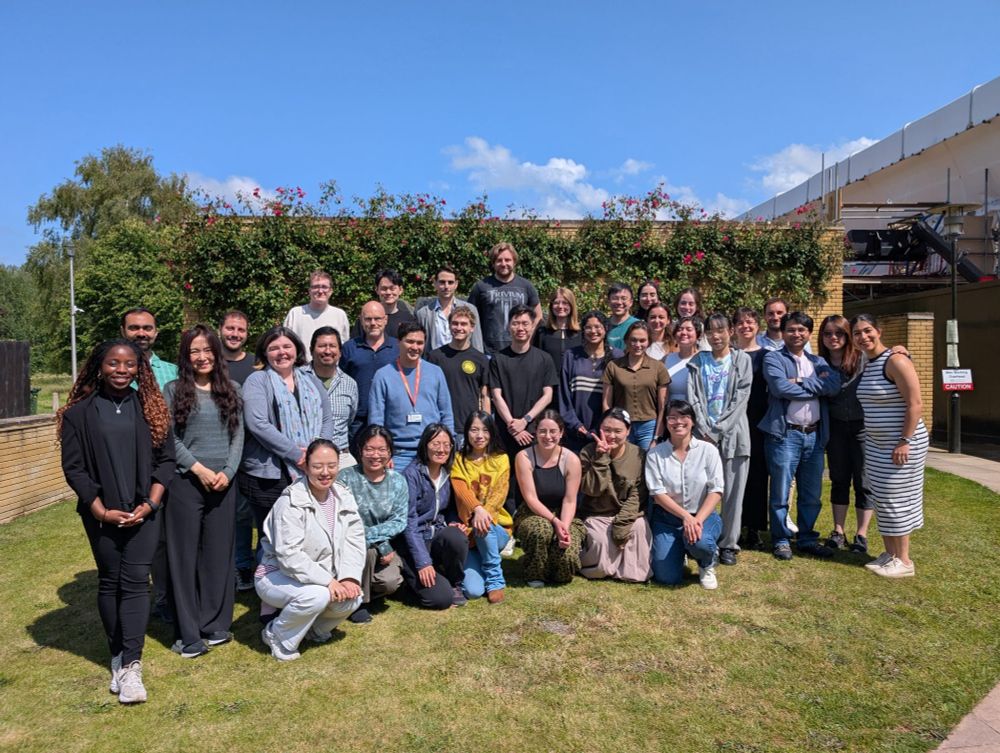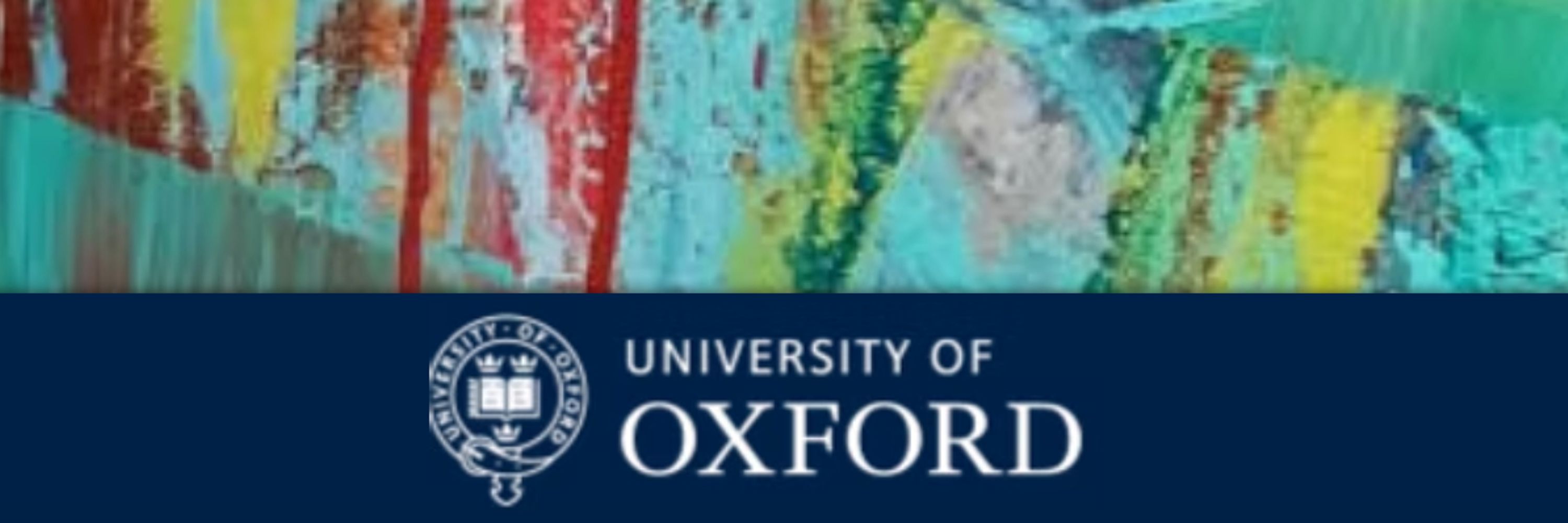
Ole Jensen
@olejensen.bsky.social
Cognitive neuroscientist investigating the role of brain oscillations.
http://www.neuosc.com
http://www.neuosc.com
Reposted by Ole Jensen
CogNeuroLanguage: new by @lauragwilliams.bsky.social & @jeanremiking.bsky.social (w Alec Marantz & me) shows how the brain maintains-updates continuously unfolding lang hierarchy during comprehension, anchoring ling theories to biological implementation
www.pnas.org/doi/10.1073/... #neuroskyence
www.pnas.org/doi/10.1073/... #neuroskyence

Hierarchical dynamic coding coordinates speech comprehension in the human brain | PNAS
Speech comprehension involves transforming an acoustic waveform into meaning. To do
so, the human brain generates a hierarchy of features that conv...
www.pnas.org
October 18, 2025 at 1:36 PM
CogNeuroLanguage: new by @lauragwilliams.bsky.social & @jeanremiking.bsky.social (w Alec Marantz & me) shows how the brain maintains-updates continuously unfolding lang hierarchy during comprehension, anchoring ling theories to biological implementation
www.pnas.org/doi/10.1073/... #neuroskyence
www.pnas.org/doi/10.1073/... #neuroskyence
Decoding performance (MVPA) better for OPM-MEG than SQUID-MEG 😎. The improved spatial specificity of OPM-MEG due to the reduced brain-sensor distance is key. And more sensors (beyond 40) don't improve decoding.
Preprint from our recent @thechbh.bsky.social study: www.biorxiv.org/content/10.1...
Preprint from our recent @thechbh.bsky.social study: www.biorxiv.org/content/10.1...

Decoding with multivariate pattern analysis is superior for optically pumped magnetometer-based magnetoencephalography compared to superconducting quantum interference device-based systems
Background: Multivariate pattern analysis (MVPA) has become an increasingly important method for decoding distributed brain activity from neural electrophysiological recordings by leveraging both temp...
www.biorxiv.org
October 16, 2025 at 12:13 PM
Decoding performance (MVPA) better for OPM-MEG than SQUID-MEG 😎. The improved spatial specificity of OPM-MEG due to the reduced brain-sensor distance is key. And more sensors (beyond 40) don't improve decoding.
Preprint from our recent @thechbh.bsky.social study: www.biorxiv.org/content/10.1...
Preprint from our recent @thechbh.bsky.social study: www.biorxiv.org/content/10.1...
Ever wonder how you read so fast? Your brain gets a head start—processing the next word before your eyes move. Our MEG + eye tracking study out in Nature Communications study from @thechbh.bsky.social reveals orthographic & semantic previews predicting reading speed www.nature.com/articles/s41...

Fast hierarchical processing of orthographic and semantic parafoveal information during natural reading - Nature Communications
Combining MEG, eye-tracking, and representational similarity analysis, this study shows that readers rapidly and sequentially extract orthographic and semantic information from upcoming words before fixation, supporting efficient reading.
www.nature.com
October 11, 2025 at 12:42 PM
Ever wonder how you read so fast? Your brain gets a head start—processing the next word before your eyes move. Our MEG + eye tracking study out in Nature Communications study from @thechbh.bsky.social reveals orthographic & semantic previews predicting reading speed www.nature.com/articles/s41...
Our new study - pseudoneglect is partly explained by structural hemispheric asymmetries in putamen 👇👇👇
🧠✨ Preprint alert!
Ever noticed how most people (without realizing it) tend to see the left side of space a bit more strongly? In our new study, we show that this subtle quirk—called pseudoneglect—is linked to the asymmetry of putamen, a deep subcortical structure.
www.biorxiv.org/content/10.1...
Ever noticed how most people (without realizing it) tend to see the left side of space a bit more strongly? In our new study, we show that this subtle quirk—called pseudoneglect—is linked to the asymmetry of putamen, a deep subcortical structure.
www.biorxiv.org/content/10.1...

Hemispheric laterality of the putamen predicts pseudoneglect
Healthy individuals tend to exhibit a subtle leftward attentional bias, a phenomenon termed pseudoneglect. While this bias is thought to reflect a right-hemisphere dominance when allocating spatial at...
www.biorxiv.org
September 19, 2025 at 2:35 PM
Our new study - pseudoneglect is partly explained by structural hemispheric asymmetries in putamen 👇👇👇
In our Trends in Cogn Sci paper we point to the connectivity crisis in task-based human EEG/MEG research: many connectivity metrics, too little replication. Time for community-wide benchmarking to build robust, generalisable measures across labs & tasks. www.sciencedirect.com/science/arti...

Confronting the connectivity crisis in human M/EEG research
The cognitive neuroscience community using M/EEG has not converged on measures of task-related inter-regional brain connectivity that generalize acros…
www.sciencedirect.com
September 18, 2025 at 3:23 PM
In our Trends in Cogn Sci paper we point to the connectivity crisis in task-based human EEG/MEG research: many connectivity metrics, too little replication. Time for community-wide benchmarking to build robust, generalisable measures across labs & tasks. www.sciencedirect.com/science/arti...
In an EEG study spearheaded by Marlena Baldauf, we show that 8-month-old babies’ visual systems resonate at 4Hz (theta rhythm) — unlike adults, who resonate around 10Hz (alpha).
👶🧠 echoes at 4Hz
👩🦰🧠 echoes at ~10Hz
Preprint:
www.biorxiv.org/content/10.1...
👶🧠 echoes at 4Hz
👩🦰🧠 echoes at ~10Hz
Preprint:
www.biorxiv.org/content/10.1...

Infant Brains Tick at 4Hz - Resonance Properties of the Developing Visual System
Neural rhythms of the infant brain are not well understood. Testing the rhythmic properties of the adult visual system with periodic or broadband visual stimulation elicited neural resonance phenomena...
www.biorxiv.org
September 15, 2025 at 1:19 PM
In an EEG study spearheaded by Marlena Baldauf, we show that 8-month-old babies’ visual systems resonate at 4Hz (theta rhythm) — unlike adults, who resonate around 10Hz (alpha).
👶🧠 echoes at 4Hz
👩🦰🧠 echoes at ~10Hz
Preprint:
www.biorxiv.org/content/10.1...
👶🧠 echoes at 4Hz
👩🦰🧠 echoes at ~10Hz
Preprint:
www.biorxiv.org/content/10.1...
Important findings from @katduecker.bsky.social : faster visual search for a target among distractors predicted by stronger alpha; ie a case where alpha benefits visual processing
At long last, the pre-print to our MEG study + RIFT study and the final paper from my Ph.D with @olejensen.bsky.social We show that strong pre-search alpha oscillations are associated with faster responses in visual search www.biorxiv.org/content/10.1...
@thechbh.bsky.social #neuroskyence
@thechbh.bsky.social #neuroskyence

September 1, 2025 at 5:52 AM
Important findings from @katduecker.bsky.social : faster visual search for a target among distractors predicted by stronger alpha; ie a case where alpha benefits visual processing
Reposted by Ole Jensen
🚨We believe this is a major step forward in how we study hippocampus function in healthy humans.
Using novel behavioral tasks, fMRI, RL & RNN modeling, and transcranial ultrasound stimulation (TUS), we demonstrate the causal role of hippocampus in relational structure learning.
Using novel behavioral tasks, fMRI, RL & RNN modeling, and transcranial ultrasound stimulation (TUS), we demonstrate the causal role of hippocampus in relational structure learning.
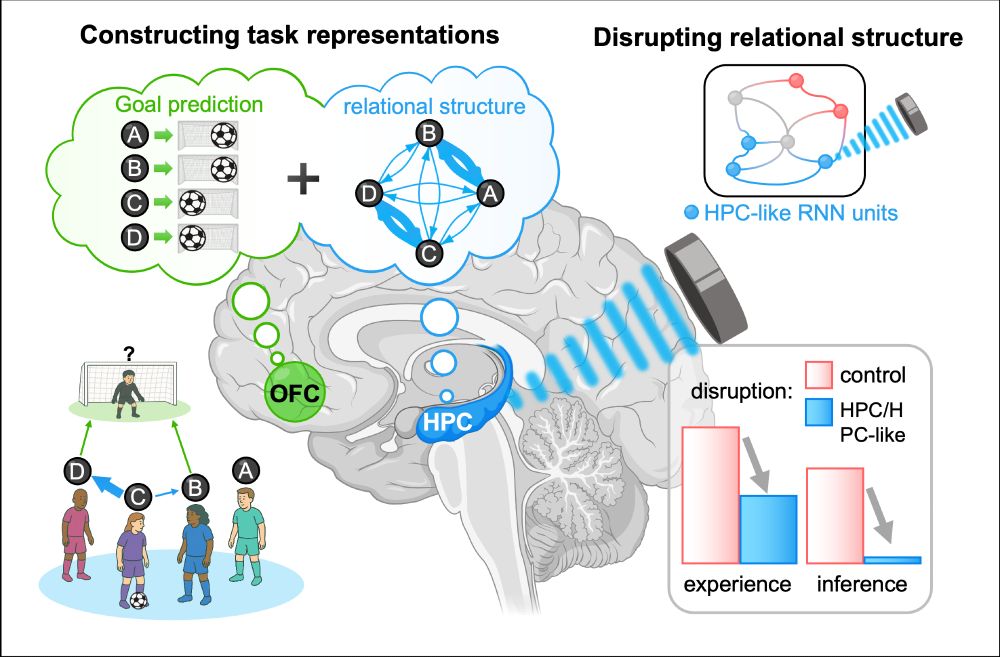
August 28, 2025 at 2:00 PM
🚨We believe this is a major step forward in how we study hippocampus function in healthy humans.
Using novel behavioral tasks, fMRI, RL & RNN modeling, and transcranial ultrasound stimulation (TUS), we demonstrate the causal role of hippocampus in relational structure learning.
Using novel behavioral tasks, fMRI, RL & RNN modeling, and transcranial ultrasound stimulation (TUS), we demonstrate the causal role of hippocampus in relational structure learning.
Join our team! We're looking for a Research Assistant to support OPM-MEG research on reading in children and adults at the Oxford Centre for Human Activity in the Neuronal Oscillations group (www.neuosc.com). Deadline 22nd July. For details see lnkd.in/e2qvCP9b
June 26, 2025 at 1:52 PM
Join our team! We're looking for a Research Assistant to support OPM-MEG research on reading in children and adults at the Oxford Centre for Human Activity in the Neuronal Oscillations group (www.neuosc.com). Deadline 22nd July. For details see lnkd.in/e2qvCP9b
In our new MEG/RIFT study from @thechbh.bsky.social by
@katduecker.bsky.social , we show that feature-guidance in visual search alters neuronal excitability in early visual cortex —supporting a priority-map-based attentional mechanism.
rdcu.be/eqFX7
@katduecker.bsky.social , we show that feature-guidance in visual search alters neuronal excitability in early visual cortex —supporting a priority-map-based attentional mechanism.
rdcu.be/eqFX7
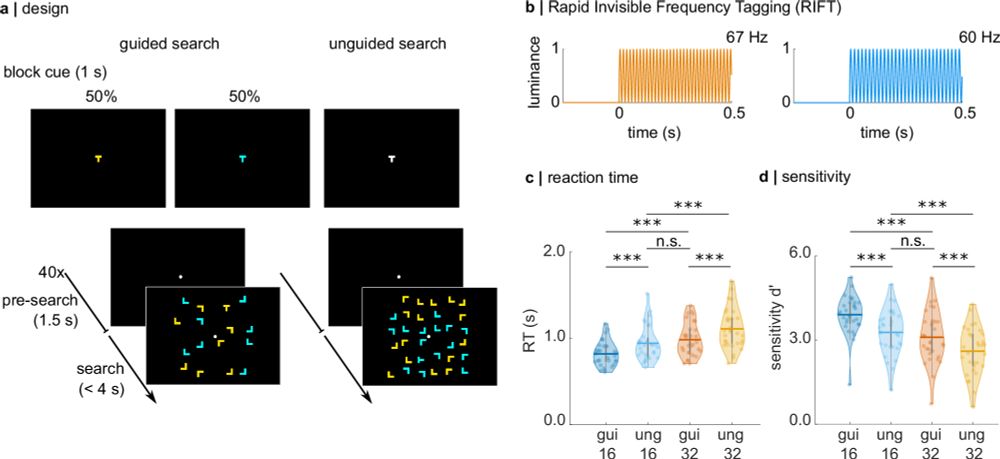
Guided visual search is associated with target boosting and distractor suppression in early visual cortex
Communications Biology - Magnetoencephalography in human participants paired with Rapid Invisible Frequency Tagging reveals that excitability in early visual cortex is modulated to boost targets...
rdcu.be
June 12, 2025 at 10:17 AM
In our new MEG/RIFT study from @thechbh.bsky.social by
@katduecker.bsky.social , we show that feature-guidance in visual search alters neuronal excitability in early visual cortex —supporting a priority-map-based attentional mechanism.
rdcu.be/eqFX7
@katduecker.bsky.social , we show that feature-guidance in visual search alters neuronal excitability in early visual cortex —supporting a priority-map-based attentional mechanism.
rdcu.be/eqFX7
Day 2 of the OPM-FLUX (www.neuosc.com/fluxtoolkit2...) toolkit at University of Oxford hosted at St Catz. We have 32 bright participants from 7 countries learning how to apply OPM-MEG in cognitive and clinical neuroscience

June 10, 2025 at 9:24 AM
Day 2 of the OPM-FLUX (www.neuosc.com/fluxtoolkit2...) toolkit at University of Oxford hosted at St Catz. We have 32 bright participants from 7 countries learning how to apply OPM-MEG in cognitive and clinical neuroscience
Our latest study on reading using MEG, eyetracking and Rapid Invisible Frequency Tagging headed by Yali Pan from @thechbh.bsky.social : Parallel and dynamic attention allocation during natural reading
www.biorxiv.org/content/10.1...
www.biorxiv.org/content/10.1...

Parallel and dynamic attention allocation during natural reading
During natural reading, attention constantly shifts across words, yet how linguistic properties (e.g., lexical frequency) impact the allocation of attention remains unclear. In this study, we co-regis...
www.biorxiv.org
May 30, 2025 at 9:00 AM
Our latest study on reading using MEG, eyetracking and Rapid Invisible Frequency Tagging headed by Yali Pan from @thechbh.bsky.social : Parallel and dynamic attention allocation during natural reading
www.biorxiv.org/content/10.1...
www.biorxiv.org/content/10.1...
During saccades, visual objects are first processed in the parafovea, then in the fovea upon fixation. Does this repeated exposure cause repetition suppression or information accumulation? MEG work by Syanah Wynn suggests both as a consequence of neural sharpening.
www.biorxiv.org/content/10.1...
www.biorxiv.org/content/10.1...
www.biorxiv.org
May 27, 2025 at 11:06 AM
During saccades, visual objects are first processed in the parafovea, then in the fovea upon fixation. Does this repeated exposure cause repetition suppression or information accumulation? MEG work by Syanah Wynn suggests both as a consequence of neural sharpening.
www.biorxiv.org/content/10.1...
www.biorxiv.org/content/10.1...
Reposted by Ole Jensen
my lab (lacns.github.io) at @mpi-nl.bsky.social and @dondersinst.bsky.social is recruiting for two PhD and two postdoctoral positions funded by an @erc.europa.eu Consolidator - come join us!
PhD: www.mpi.nl/career-educa...
Postdoc: www.mpi.nl/career-educa...
(please share widely)
PhD: www.mpi.nl/career-educa...
Postdoc: www.mpi.nl/career-educa...
(please share widely)
Language and Computation in Neural Systems
We are an international group of scientists consisting of linguists, cognitive scientists, cognitive neuroscientists, computational neuroscientists, computational modellers, computational scientists, ...
lacns.github.io
May 20, 2025 at 1:49 PM
my lab (lacns.github.io) at @mpi-nl.bsky.social and @dondersinst.bsky.social is recruiting for two PhD and two postdoctoral positions funded by an @erc.europa.eu Consolidator - come join us!
PhD: www.mpi.nl/career-educa...
Postdoc: www.mpi.nl/career-educa...
(please share widely)
PhD: www.mpi.nl/career-educa...
Postdoc: www.mpi.nl/career-educa...
(please share widely)
Reposted by Ole Jensen
📣cog neuro postdoc opportunity! Interested in studying attention & exploration w/ cutting edge M/EEG? 🧠care about making vision science a bit more naturalistic? 🌱LandauLab is hiring! We seek resourceful, curious and creative researchers who can join the newly forming London-based team@ucl.ac.uk! ...

UCL – University College London
UCL is consistently ranked as one of the top ten universities in the world (QS World University Rankings 2010-2022) and is No.2 in the UK for research power (Research Excellence Framework 2021).
www.ucl.ac.uk
May 15, 2025 at 4:07 PM
📣cog neuro postdoc opportunity! Interested in studying attention & exploration w/ cutting edge M/EEG? 🧠care about making vision science a bit more naturalistic? 🌱LandauLab is hiring! We seek resourceful, curious and creative researchers who can join the newly forming London-based team@ucl.ac.uk! ...
Hands-on training at University of Oxford using OPM in cognitive and clinical neuroscience. Deadline 23/05/2025
We are delighted to announce the first OPM-FLUX toolkit to be held 9th-12th June 2025 at St. Catherine's College at University of Oxford: neuosc.com/fluxtoolkit2...

May 15, 2025 at 5:09 PM
Hands-on training at University of Oxford using OPM in cognitive and clinical neuroscience. Deadline 23/05/2025
Oscar Ferrante from @thechbh.bsky.social and his colleagues Rony Hirschhorn and Alex Lepauvre on Brain Inspired, reflecting on the Cogitate collaboration and the recent Nature paper.
In this episode of “Brain Inspired,” Paul Middlebrooks talks with Oscar Ferrante, Rony Hirschhorn and Alex Lepauvre about putting integrated information and global neuronal workspace theories of consciousness to the test. Listen now: www.thetransmitter.org/brain-inspir...
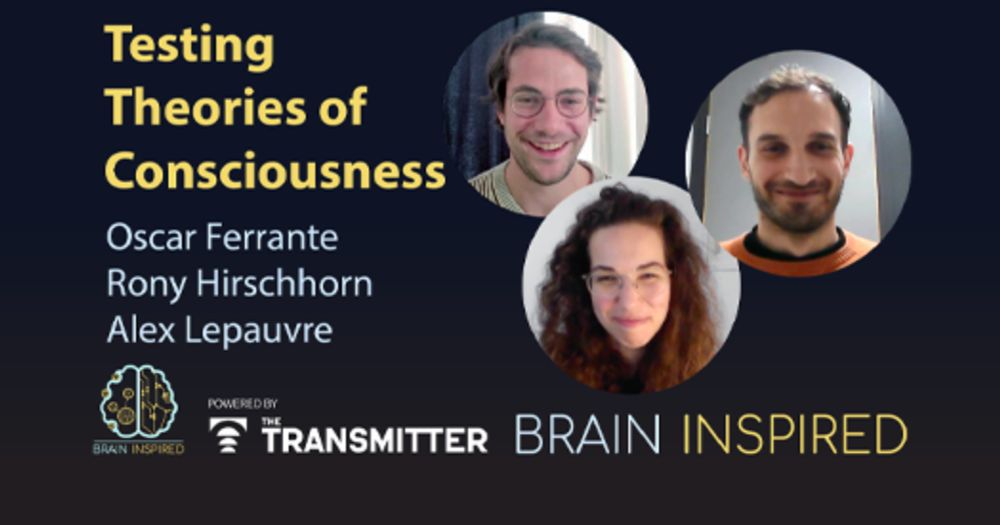
Oscar Ferrante, Rony Hirschhorn and Alex Lepauvre discuss putting integrated information and global neuronal workspace theories of consciousness to the test
The trio is part of the adversarial collaboration launched to test various theories of consciousness, a project known as COGITATE.
www.thetransmitter.org
May 8, 2025 at 12:22 PM
Oscar Ferrante from @thechbh.bsky.social and his colleagues Rony Hirschhorn and Alex Lepauvre on Brain Inspired, reflecting on the Cogitate collaboration and the recent Nature paper.
And a wonderful podcast on Brain Inspired by the excellent postdocs/PhDs from the COGITATE team (@arc-cogitate.bsky.social) reflecting on their experience of being part of the adversarial collaboration on consciousness
braininspired.co/podcast/211/
braininspired.co/podcast/211/
May 8, 2025 at 12:18 PM
And a wonderful podcast on Brain Inspired by the excellent postdocs/PhDs from the COGITATE team (@arc-cogitate.bsky.social) reflecting on their experience of being part of the adversarial collaboration on consciousness
braininspired.co/podcast/211/
braininspired.co/podcast/211/
Interesting and timely editorial in Nature on the importance of adversarial collaborations
www.nature.com/articles/d41...
www.nature.com/articles/d41...

Make science more collegial: why the time for ‘adversarial collaboration’ has come
Bringing together proponents of rival theories to test their ideas against each other can advance science — but only if all sides can accept that they might be wrong.
www.nature.com
May 8, 2025 at 12:14 PM
Interesting and timely editorial in Nature on the importance of adversarial collaborations
www.nature.com/articles/d41...
www.nature.com/articles/d41...
Reposted by Ole Jensen
The 2025 edition of MEG UKI will be hosted by UCL 16-18th July. This year we include a multimodal day on naturalistic neuroscience! Abstract submission is also now open. meguk.ac.uk/meg-uki-2025/
MEG-UKI 2025 | UCL London | 16–18 July – MEG UKI
meguk.ac.uk
April 28, 2025 at 12:56 PM
The 2025 edition of MEG UKI will be hosted by UCL 16-18th July. This year we include a multimodal day on naturalistic neuroscience! Abstract submission is also now open. meguk.ac.uk/meg-uki-2025/
Reposted by Ole Jensen
Researchers in France are working on creating a french network of researchers to organize interaction, communication and training in #Computational_Neuroscience. If you are a CompNeuro working in France, consider joining, and registering to our mailing list: listes.services.cnrs.fr/wws/subscrib...
rt_neurocomp - réseau français de neurosciences computationnelles - subscribe
listes.services.cnrs.fr
May 2, 2025 at 12:03 PM
Researchers in France are working on creating a french network of researchers to organize interaction, communication and training in #Computational_Neuroscience. If you are a CompNeuro working in France, consider joining, and registering to our mailing list: listes.services.cnrs.fr/wws/subscrib...
Reposted by Ole Jensen
Our @nature.com paper is out! Bringing together 2 major theories of consciousness - Integrated Information Theory (IIT) and Global Neuronal Workspace Theory (GNWT) - in an unprecedented collaboration. Here’s the story of how we advanced theory testing in neuroscience
www.nature.com/articles/s41...
www.nature.com/articles/s41...
April 30, 2025 at 3:34 PM
Our @nature.com paper is out! Bringing together 2 major theories of consciousness - Integrated Information Theory (IIT) and Global Neuronal Workspace Theory (GNWT) - in an unprecedented collaboration. Here’s the story of how we advanced theory testing in neuroscience
www.nature.com/articles/s41...
www.nature.com/articles/s41...
Reposted by Ole Jensen
I'm so happy for the friends I made working on this project, and proud of the work we have put together
Our @nature.com paper is out! Bringing together 2 major theories of consciousness - Integrated Information Theory (IIT) and Global Neuronal Workspace Theory (GNWT) - in an unprecedented collaboration. Here’s the story of how we advanced theory testing in neuroscience
www.nature.com/articles/s41...
www.nature.com/articles/s41...
April 30, 2025 at 3:41 PM
I'm so happy for the friends I made working on this project, and proud of the work we have put together
Reposted by Ole Jensen
I lost count of how many times I said, “I’ll believe it when I see it", and here we are. It's been a privilege to be part of @arc-cogitate.bsky.social and to learn from such brilliant people (especially grateful to @liadmudrik.bsky.social for the opportunity to join this massive project)

April 30, 2025 at 4:27 PM
I lost count of how many times I said, “I’ll believe it when I see it", and here we are. It's been a privilege to be part of @arc-cogitate.bsky.social and to learn from such brilliant people (especially grateful to @liadmudrik.bsky.social for the opportunity to join this massive project)


